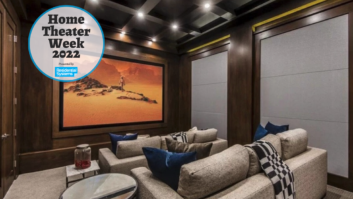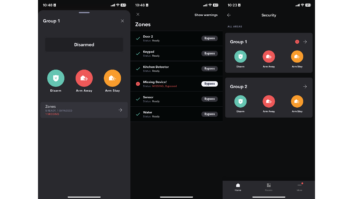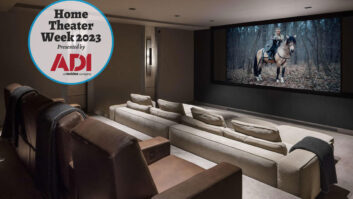
The GrandCare System revolves around an in-home touchscreen terminal that provides a variety of communication and socialization tools, including video chatting, medication reminders, and one-touch access to messages, photos, and videos from family members to help keep seniors engaged. It’s no secret that America is graying. Every day, 10,000 of the nation’s 78 million baby boomers turn 65. This unparalleled march to retirement is having a profound effect on a society already wrestling with the spiraling cost of healthcare, which is where technology and, potentially, residential integrators come into play. The market for technology to assist aging adults and those with chronic health conditions is projected to increase 10-fold over the next seven years, climbing from $2 billion to $20 billion by 2020 as companies introduce more digital home health products and Americans seek ways to help seniors remain home longer, or “age in place,” instead of moving into assisted living.
At the core of this nascent market are wireless sensors and networking technologies that home automation specialists deal with every day, raising this question: Is digital home health the next frontier for residential integrators?
Surveys show that baby boomers, who are predisposed to using technology and have more spending power than any other age group, have a very strong desire to live at home as they age. And nine out of 10 seniors say they also want to stay at home and believe technology can help them age in place, even though they are largely unaware of the solutions that exist today. Add to that growing life expectancy the propensity for chronic conditions such as high blood pressure, the expectation among boomers that they will be caring for an older loved one in the next few years, the exorbitant cost of assisted living, and the need to preserve over-stretched retirement funds, and you have a population tailor made for digital home health technology.
“We do believe the tipping point has arrived,” said Laura Mitchell, vice president of business development for Wisconsin-based GrandCare Systems, a pioneer in digital home health that has been selling an ”intelligent client-based system with a cloud-based caregiving portal” since 2006. “We’re starting to see interest from all sorts of major organizations, including cable and wireless providers. And with the Affordable Care Act, Medicare will no longer reimburse for hospital readmissions that happen within 30 days of discharge, which means the hospital and insurance payers are much more interested in finding technologies that can help these individuals transition safely to the home. Another factor is the fact that we don’t have enough brick and mortar or enough caregivers to take care of our aging population. If we don’t use technology as an enabling tool, we will bankrupt our children and grandchildren.”
The GrandCare System revolves around an in home touchscreen terminal that provides a variety of communication and socialization tools, including video chatting, medication reminders, and one touch access to messages, photos, and videos from family members to help keep seniors engaged. But more important, the system uses strategically placed sensors to enable caregivers to remotely monitor the daily activities of an elderly person or someone with a chronic condition to help ensure their safety and well being. The monitoring is customized to address specific circumstances, which could be a frail senior with limited mobility or someone in the early stages of Alzheimer’s disease.

Successful dealers have invested between $10,000 and $30,000 to start up a GrandCare installation business, according the company’s Laura Mitchell. “The caregiver can log into our online portable and set up rules and parameters,” Mitchell explained. “For example, she could set up a rule that says, ‘If mom gets out of bed during the night and doesn’t return within 45 minutes, call my cell phone or send me a text message.’” A sensor in the bedroom would register the activity and trigger an alert. Other possibilities include monitoring whether someone is eating and taking medication. Finally, the GrandCare System supports health monitoring through the use of complementary telehealth devices that measure blood pressure, weight, and glucose levels.
Digital Health Here I Come
In a market that is growing exponentially, there is a clear opportunity for custom integrators– one that is profitable and makes use of existing installation skills. But it is not without its challenges. Technology professionals working in the field are quick to point out that selling a remote monitoring health system is completely different than selling home automation or entertainment. It’s a personal sale that requires educating the caretaker and client, as well as sensitivity to medical conditions and budget issues, not the least of which is the fear of running out of money. The integrator has to become an expert in home healthcare–or align with an expert–and form partnerships with healthcare professionals. It’s hard work.
“This is not something you can just put on your website and expect that everyone will buy it,” Mitchell explained. “It’s really about personal consulting and figuring out what system is best for this person. You’re not selling them on features, but instead, selling a full solution based on their unique situation. You can’t go in and ask a potential customer, ‘Well, how many motion sensors would you like?’”
GrandCare has found that forging strategic alliances with healthcare organizations is a critical ingredient to success. “It’s been the difference between those who have succeeded in this field and those who have not,” Mitchell said. “Some of our best and most valuable ‘salespeople’ are geriatric care managers, because they have credibility.”
When a care manager or professional caregiver goes in and talks to you and your mom, you feel like they know what they’re talking about versus maybe a 25- to 40-year-old tech person, where you’re thinking, ‘Yeah, I’m sure you can install a really great system but do you know what I need? That’s not to say you can’t learn this industry–you can–but why reinvent the wheel? Why not stick to what you do well and partner with a home healthcare professional? With that synergy, it’s perfect.”
It Takes a Lighter Touch
Selling digital home health requires a fragile approach because you’re dealing with medical and life safety issues. Sensitivity is key–it not a technical sale, explained Jude Harper, a registered communications distribution designer (RCDD) with expertise in telecommunications infrastructure and home automation and director of operations for New Jersey-based Harper Technology Group (HTG), which has been selling the GrandCare platform since 2008. “You need to have an understanding of your client and educate yourself about interacting with people in the medical profession who know zero about technology,” she said. “They have a people-to-people relationship, and we have a people-to- machine relationship. The only way to blend those worlds together effectively is to have the best of both worlds on your staff,” which in HTG’s case means having a registered nurse and a retired physician on staff–both of whom have relationships with caregiving organizations– and partnering with a geriatric consultant/ advisor.
Tom Ardolf, owner of Minnesota-based Cybermation, a long-time home automation installation company that transitioned to digital health and recently became a GrandCare distributor, said, “It’s a very good vertical to be in and the time is now for people who are considering it, but you have to change from a business-to-consumer operation to a B-to-B operation, which is something most integrators can’t do.”
Ardolf was fortunate in that from 1986 to 2006 he also owned a B-to-B company that sold software and services, so he knew how to handle that type of sale. “You really need to be out there selling through home healthcare organizations,” Ardolf continued. “We’ve even had people use the system for hospice situations. There are a variety of ways to implement a system that has depth of GrandCare for activities of daily living (ADL) monitoring, clinical monitoring–blood pressure, glucose levels, etc.–and socialization, which are its three key elements.”
Unlike HTG’s business, which is about 70 percent residential and 30 percent commercial, Ardolf made the choice to focus on B-to-B because he felt the market had not coalesced enough to build a business on residential end-user sales. “We teach home healthcare organizations how the technology works and then it’s up to them how to apply it to their customers,” he said.
Getting into the Business
Moving into digital home health takes dedication and perseverance, as well as an investment in time and money.
“Our successful dealers have made an investment just like you do with any business and not just in advertising–because you don’t want to advertise until the market is ready–but in hiring the right people, being at the right events and gaining trust in the community as the aging in place expert,” Mitchell said.
“The biggest investment of all is your time,’ Ardolf added. ”I knew nothing about home healthcare or government reimbursement policies. I spent two years doing what my insurance company agent called missionary work, trying to speak with people about what we do and, frankly, learning the market. After we started gaining some traction, I hired someone with healthcare experience. If I could do it over and had the money, I would hire that person from the get-go. That will get you up to speed faster.”
In addition to putting together a rock-solid business plan, it takes at least six months to learn the product and bring your organization up to speed before launch, Harper said, noting that you have be prepared to engage in ongoing education. “We educate every day. We go out to senior citizen centers and give presentations. We work with caregivers. We’re at the point now where our work is really starting to pay off. We’re building a name within the community.”
Investment and Profit Potential
Successful GrandCare dealers have invested between $10,000 and $30,000 to start up a business like this, according to Mitchell. That includes a demo system that dealers are required to have on hand. “Having systems in inventory is not as critical, but it’s attending trade shows, exhibiting at events, educating yourself and just being out there,” she explained.
Hardware margins are typically in the 20- to 40-percent range, according to Ardolf. That is in addition to recurring revenue from GrandCare’s monthly subscription fee plus residuals from complementary monitoring devices, which have their own monthly fees.
“Every integrator is different in how they structure their margins,” Harper said. “We aim to stay in the 17-percent range on average, so for us, 15 to 20 percent is good and 30 percent is phenomenal. But when you’re selling a system to someone in their 80s, it comes down to the bottom line number, so you really have to price the system for people in need, many of whom have limited income. Then there are the residuals, which could be between $20 to $30 a month per system.”
The value of a typical HTG system is between $3,500 and $4,300, according to Harper, who said customers often start with a basic $1,300 system and eventually “upsell themselves” with add-ons in all different price ranges.
In addition to health monitoring devices, HTG sells GPS tracking “watches” for people with Autism or Alzheimer’s who tend to wander and an “I’m Okay” button that an elderly or chronically ill person who “doesn’t want to be called five times a day“ can push to let loved ones know everything is fine.
HTG also set up an in-house rental program with a buy-back option to keep costs low for elderly clients. “Each business will have to figure out where they want to go,” Harper said. “Are you looking to make money right off the bat or is it a three- to five-year plan?”
Of course, integrators with home automation experience have the know-how to offer additional customization services, which might include battery back-up, beefing up a home network or adding path lighting to make it easier for an elderly person to get from the bedroom to the bathroom at night. There’s also the potential to sell service contracts.
Taking things further, many custom integrators have the wherewithal to improve the acoustics or lighting in home environments to make them safer and more “perceptually comfortable” for elderly clients with compromised hearing and vision. Aging in place research conducted by Minneapolis-based Orfield Laboratories revealed that as we get older our ability to deal with glare drops dramatically, creating an opportunity to design a glare-free AV setup, which would likely mean changes in lighting and TV placement.
“Similarly, as you get older, reverberation time–the ‘liveness’ of the room–becomes inversely proportional to audio clarity or speech intelligibility,” according to lab founder Steve Orfield. This creates an opportunity to install acoustical treatments that will make listening to music or watching a movie a more pleasurable experience for the elderly.
In the end, Harper believes all of his hard work is paying off in terms of personal gratification and relationships he’s built. “When you improve someone’s life, it really humbles you and makes you appreciate not only the power of the technology but the team that brings it to market.”
Bob Ankosko is a freelance journalist and editorial consultant who has been covering consumer electronics for more than 25 years.






